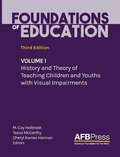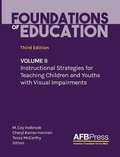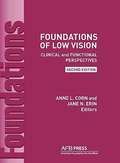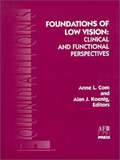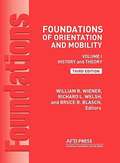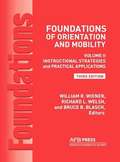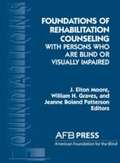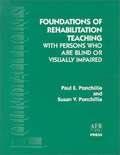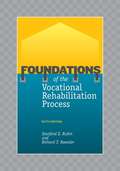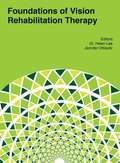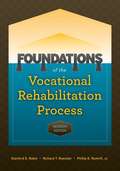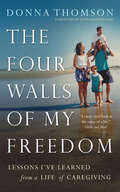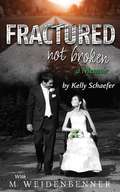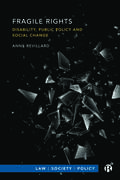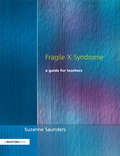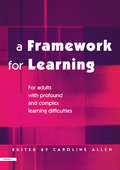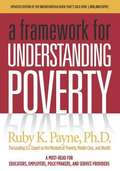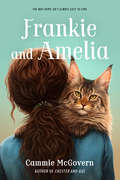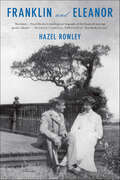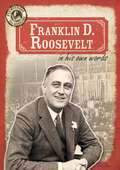- Table View
- List View
Foundations of Education 3e, Vol 1
by M. Cay Holbrook Tessa Mccarthy Cheryl Kamei-Hannan EditorsThe highly anticipated third edition of the essential textbook in the field of blindness and visual impairment is completely revised and updated for the 21st century. In addition to the latest information and best practices, Volume I, History and Theory of Teaching Children and Youth with Visual Impairments, includes a whole new set of chapters that provide additional perspectives on the educational system and focus on crucial topics that connect the education of students with visual impairment to the broader context of educational theory. Volume II, Instructional Strategies for Teaching Children and Youths with Visual Impairments, contains additional material on planning instruction, moving from assessment to instruction, and supporting students with visual impairments in the general education classroom. Instructional strategies are also highlighted, with chapters dedicated to each area of the core or expanded core curriculum. Icons located throughout both volumes direct readers to audio introductions, chapter overviews, learning activities, videos, resource lists, and downloadable forms housed in an exclusive, web-based Learning Center that enriches this foundational textbook as never before.
Foundations of Education for Blind and Visually Handicapped Children and Youth Theory and Practice
by Geraldine T. SchollBlind children -- Education. Children with visual disabilities -- Education.
Foundations of Education Volume 2: Instructional Strategies for Teaching Children and Youths with Visual Impairments
by M. Cay Holbrook Tessa Mccarthy Cheryl Kamei-Hannan EditorsThe highly anticipated third edition of the essential textbook in the field of blindness and visual impairment is completely revised and updated for the 21st century. In addition to the latest information and best practices, Volume I, History and Theory of Teaching Children and Youth with Visual Impairments, includes a whole new set of chapters that provide additional perspectives on the educational system and focus on crucial topics that connect the education of students with visual impairment to the broader context of educational theory. Volume II, Instructional Strategies for Teaching Children and Youths with Visual Impairments, contains additional material on planning instruction, moving from assessment to instruction, and supporting students with visual impairments in the general education classroom. Instructional strategies are also highlighted, with chapters dedicated to each area of the core or expanded core curriculum. Icons located throughout both volumes direct readers to audio introductions, chapter overviews, learning activities, videos, resource lists, and downloadable forms housed in an exclusive, web-based Learning Center that enriches this foundational textbook as never before.
Foundations of Low Vision: Clinical and Functional Perspectives (2nd Edition)
by Anne Corn Jane N. ErinThe editors and contributors of this book provide an examination of the clinical and functional perspectives of low vision. New to the second edition are revisions in all areas, state-of-the-art technology, a reorganization to examine in more depth the needs of individuals in different age ranges, new charts, certification requirements for low vision therapists, and information on pathology, early development, and discussion of the relationship between the vision and the brain.
Foundations of Low Vision: Clinical and Functional Perspectives
by Alan J. Koenig Anne L. CornThis text explains in great detail how to do low vision exams, the principles behind magnifiers and other forms of magnification, and much more.
Foundations Of Orientation And Mobility: Volume 1: History And Theory
by William Wiener Richard Welsh Bruce BlaschFoundations of Orientation and Mobility, the classic professional reference and textbook has been completely revised and expanded to two volumes by the most knowledgeable experts in the field. The new third edition includes both the latest research in O&M and expanded information on practice and teaching strategies. Volume 1, History and Theory, includes the bases of O&M knowledge, including perception, orientation, low vision, audition, kinesiology, psychosocial issues, and learning theories, as well as chapters on technology, dog guides, orientation aids, and environmental accessibility. A section on the profession of O&M includes its international history; administration, assessment and program planning; and a chapter on research in O&M. No O&M student or professional can afford to be without this essential resource.
Foundations of Orientation and Mobility (2nd Edition)
by Bruce B. Blasch William R. Wiener Richard L. WelshA text for specialists in orientation and mobility, providing background information on physiology and function of human perceptual and motor systems. A section on human systems addresses areas including low vision, kinesiology, and sensorimotor function, and a section on mobility systems deals with tools, materials, and techniques such as canes, electronic travel aids, trained dogs, and changes in the built environment that facilitate travel for blind people. A section on the learner focuses on approaches for teaching children, adults, and those with multiple impairments. A final section reviews development of the profession from the post WWII-era to the present, and looks at future trends. Includes bandw photos and learning activities. This edition incorporates changes in the field since 1980. Annotation copyrighted by Book News, Inc. , Portland, OR
Foundations of Orientation and Mobility, Volume 2: Instructional Strategies and Practical Applications (Third Edition)
by William R. Wiener Richard L. Welsh Bruce B. BlaschThis edition aims at adapting to needs of the changing population and environment, and to best educate new O&M specialists as well as to update currently practicing O&M specialists and other professionals.
Foundations of Rehabilitation: Counseling with Persons Who Are Blind or Visually Impaired
by J. Elton Moore William H. Graves Jeanne Boland PattersonRehabilitation professionals have long recognized that the needs of people who are blind or visually impaired are unique and require a special knowledge and expertise for the provision and coordination of effective rehabilitation services. Contributions to this text from more than 25 experts provide essential information on subjects such as functional, medical, vocational and psychological assessments; demographic and cultural issues; placement and employment issues; and the rehabilitation team. Each chapter includes a Learning Activities section that can be used in class assignments or during in-service training. Sample forms, such as a Job Analysis Worksheet, a Comprehensive Vocational Evaluation System Protocol, an Individualized Written Rehabilitation Program, and a Work Environment Visual Demands Report are included in the appendices. An extensive glossary provides easy access to clear definitions of terms.
Foundations of Rehabilitation: Teaching with Persons Who Are Blind or Visually Impaired
by Paul E. Ponchillia Susan V. PonchilliaThe first comprehensive textbook on rehabilitation teaching with people who are blind or visually impaired, this book provides practical information and specific instructional strategies as well as an overview of the profession, its history and development, and management of a rehabilitation teaching caseload. Written by two experienced teachers and prominent educators, this volume includes chapters on low vision skills, communication skills, and daily living skills, including food preparation, personal management, home management, and leisure and recreation, presenting proven techniques and detailed, step-by-step lesson plans for specific skills in each area. Information is offered on the needs of adult learners and individuals with adventitious or congenital visual impairments, along with valuable sample forms for assessing and planning the needs and course of instruction for new clients.
Foundations of the Vocational Rehabilitation Process (6th edition)
by Stanford E. Rubin Richard RoesslerIn this sixth edition guide for professionals in vocational rehabilitation (as well as families and individuals who want to understand and participate in planning rehabilitation), Rubin (emeritus, rehabilitation, Southern Illinois University) and Roessler (rehabilitation, human resources and communication, University of Arkansas) discuss government and societal acts concerning the disabled and what should be considered reasonable goals. Then they treat the clients, their needs, and the role of the counselor and give concrete advice on evaluation, support services, jobs, and independent living. There is also a chapter on the particular problems faced by women with disabilities. A clear and useful guide. Annotation ©2008 Book News, Inc., Portland, OR (booknews.com)
Foundations of Vision Rehabilitation Therapy
by Helen Lee Jennifer OttowitzFoundations of Vision Rehabilitation Therapy continues the legacy of Paul Ponchillia and Sue Ponchillia's seminal work Foundations of Rehabilitation Teaching with Persons Who Are Blind or Visually Impaired. After it was published in 1996, that book quickly established itself as an essential reference for vision rehabilitation professionals. Foundations of Vision Rehabilitation Therapy builds on that important work, reflecting changes in terminology and technology, while also incorporating best practices based on the past decades of evidence. It reflects the contemporary understanding of adult learning and skill building, providing proven techniques to help people with visual impairments develop skills and gain confidence that will equip them to lead independent, fulfilling lives.
Foundations Of The Vocational Rehabilitation Process
by Stanford E. Rubin Richard Roessler Phillip D. RumrillThe seventh edition of Foundations of the Vocational Rehabilitation Process provides historical, philosophical, legislative, and sociological foundations for the habilitation/rehabilitation of persons with disabilities. A thorough and current introduction to the American vocational rehabilitation process, this edition addresses mandates presented in the current major pieces of disability legislation influencing the practice of rehabilitation.This book presents theoretical and practical assistance in translating those mandates into positive action. It is this dual process of individual and environmental proactivity that can maximize the rehabilitation of disabled individuals. Not just for the dedicated rehabilitation counselor, this book is also for students attending an introductory course at the master's- or senior-level and in-service directors who design informative training programs. New in the seventh edition:Updated chapter on how "The Americans with Disabilities Act" (ADA), as amended in 2008, prohibits discrimination on the basis of disability in employment, public services, accommodations, and telecommunications. Updated section on the right to medical treatment in light of the 2012 "Affordable Care Act" (ACA). New information and updated references were added on the five disability types--physical disabilities, emotional disorders, intellectual disabilities, learning disabilities, and visual impairments and blindness. Now includes more than 1300 references, 300 of which are new.
The Four Walls of My Freedom: Lessons I've Learned from a Life of Caregiving
by Donna ThomsonA riveting and redemptive family memoir, The Four Walls of My Freedom is Donna Thomson’s account of raising a son with cerebral palsy and a passionate appeal to change the way we think about “the good life.”Donna Thomson’s life was forever changed when her son Nicholas was born with cerebral palsy. A former actor, director, and teacher, Donna became his primary caregiver and embarked on a second career as a disability activist, author, and consultant.Thomson vividly describes her experience in treading delicately through daily care, emergencies, and medical bureaucracy as she and her family cope with her son’s condition while maintaining value and dignity (for Nicholas, too). She brilliantly demonstrates the vital contribution that people with disabilities make to our society and addresses the ethics and economics of giving and receiving care.Featuring an introduction by John Ralston Saul, and two new chapters, The Four Walls of My Freedom is a passionate appeal to change to the way we think about the “good life” that will touch anyone caring for the life of another.
Fractured not Broken, A Memoir
by Kelly Schaefer M. WeidenbennerFractured Not Broken is a true story of loss, faith, and a rare love that only happens in nonfiction.In a sweeping and heart-wrenching narrative, Kelly exposes the truth about what happened after a drunk driver rendered her a quadriplegic. She shares how she found her way back--through faith and pain, her community, her family, and the love of a man she prayed for.
Fragile Innocence
by James Reston Jr.When the author's daughter suffers brain damage from a high fever, he and his wife go on a quest to find the cause and hopefully a cure.
Fragile Rights: Disability, Public Policy, and Social Change
by Anne RevillardThe French version of this book was the winner of the 2022 Grand Prix de la Protection Sociale. Over the years many disability-related rights have been legally recognized, but how has this changed the everyday lives of people with disabilities? Drawing on biographical interviews collected from individuals with mobility or visual impairments in France, this book analyses the reception of disability policies in the fields of education, employment, social rights and accessibility. It examines to what extent these policies contribute to the realization of associated rights among disabled people. The book demonstrates that the rights associated with disability suffer from major implementation flaws, while shedding light on the very active role of disabled citizens in the realization of their rights.
Fragile X Syndrome: A Guide for Teachers
by Suzanne SaundersFragile X Syndrome is thought to be the most common inherited cause of learning difficulties. However many people have never heard of it and those who have, including many of the professionals who work with those affected by it, have little knowledge or understanding of the condition. This book brings up to date research with information and advice from teachers who are discovering, first hand, the best ways of educating children with Fragile X. It is much needed support and advice that will help teachers to understand the child with Fragile X and encourage maximum educational progress. / While the book is aimed at teachers, it is also an excellent resource for parents, therapists and any professional working with a child who has Fragile X.
A Framework for Learning: For Adults with Profound and Complex Learning Difficulties
by Caroline AllenThis book offers carers, practitioners and managers a tried and tested structure for enabling adults with a range of complex needs to develop their individual skills and experience. It also provides a flexible framework which is suitable for specialist colleges and training centers for people with learning difficulties.
A Framework for Understanding Poverty (4th Revised Edition)
by Ruby K. PayneThis book presents the issues central to teaching students from poverty, then takes a pivotal next step by offering proven tools educators can use immediately to improve the quality of instruction in their classrooms.
Franka: A Guide Dog
by Walter JohnsonWhen the Allen family discovered they would be going to South America for a year, they had to make a hard decision. What would they do with Franka their beautiful German Shepherd dog. The two kids Joe and Joan write the Seeing Eye and Franka is accepted into the program. Dan, Franka's trainer, is very impressed with the intelligence of Franka. When Jane Wilson arrives at the Seeing Eye for training, Dan knows Franka is the dog for her. Jane and Franka train and graduate andjane goes on to be a lecturer on guide dogs and other topics. Good historical perspective of the Seeing Eye, and the training at the school at the time. Good children's book, but good for all ages.
Frankie and Amelia
by Cammie McGovernA heartfelt companion novel to the critically acclaimed Chester and Gus about inclusivity, autism, friendship, and family, perfect for fans of Sara Pennypacker and Kate DiCamillo. <p><p> After being separated from his family, Franklin becomes an independent cat, until he meets a goofy dog named Chester. Chester is a service dog to his person, a boy named Gus, and Chester knows just the girl to be Franklin’s person—Gus’s classmate, Amelia. Amelia loves cats, but has a harder time with people. Franklin understands her, though, and sees how much they have in common. When Amelia gets into some trouble at school, Franklin wants to help the girl who’s done so much to help him. He’s not sure how, yet, but he’s determined to try. <p><p> This sweet and moving novel demonstrates how powerful the bond between pets and people can be, while thoughtfully depicting a neurodivergent tween’s experience.
Frankincense and Murder (Duncan Maclain Mystery #12)
by Baynard KendrickCyanide in sleeping pills, a C.P.A. in debt, and many suspects at one party: the Captain, Duncan MacLain, is on the case. Can he sniff out an answer before this fragrant mystery kills again?
Franklin and Eleanor: An Extraordinary Marriage
by Hazel RowleyFranklin Delano and Eleanor Roosevelt's marriage is one of the most celebrated and scrutinized partnerships in presidential history. It raised eyebrows in their lifetimes and has only become more controversial since their deaths. From FDR's lifelong romance with Lucy Mercer to Eleanor's purported lesbianism—and many scandals in between—the American public has never tired of speculating about the ties that bound these two headstrong individuals. Some claim that Eleanor sacrificed her personal happiness to accommodate FDR's needs; others claim that the marriage was nothing more than a gracious façade for political convenience. No one has told the full story until now. In this groundbreaking new account of the marriage, Hazel Rowley describes the remarkable courage and lack of convention—private and public—that kept FDR and Eleanor together. She reveals a partnership that was both supportive and daring. Franklin, especially, knew what he owed to Eleanor, who was not so much behind the scenes as heavily engaged in them. Their relationship was the product of FDR and Eleanor's conscious efforts—a partnership that they created according to their own ambitions and needs.In this dramatic and vivid narrative, set against the great upheavals of the Depression and World War II, Rowley paints a portrait of a tender lifelong companionship, born of mutual admiration and compassion. Most of all, she depicts an extraordinary evolution—from conventional Victorian marriage to the bold and radical partnership that has made Franklin and Eleanor Roosevelt go down in history as one of the most inspiring and fascinating couples of all time.
Franklin D. Roosevelt in His Own Words
by John SheaFranklin D. Roosevelt was one of the most powerful and popular US presidents. He was the only one to serve 12 years and was elected four times. As the leader of the nation, he saw the country through an economic depression and World War II. Through primary sources, personal and political writings, and quotations, readers will become familiar with the man behind the famous name, from his early life to his momentous presidency. This book is a unique way to examine US history in the early twentieth century through the biography of one remarkable man.
